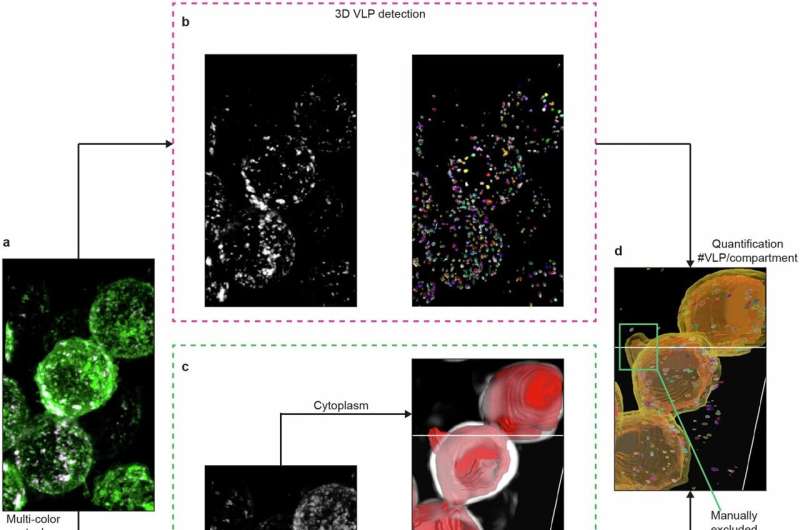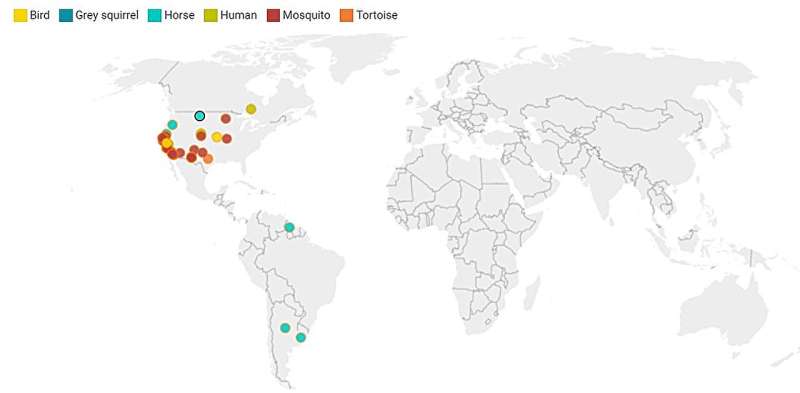This article has been reviewed according to Science X's editorial process and policies. Editors have highlighted the following attributes while ensuring the content's credibility:
fact-checked
peer-reviewed publication
trusted source
proofread
Mutating virus fate reveals key pandemic prep insights

The story of the rise and fall of western equine encephalitis as a lethal disease offers essential lessons about how a pathogen can gain or lose its ability to jump from animals to humans.
That story is captured in newly published research from Harvard Medical School that identifies the mechanisms the western equine encephalitis virus used to infect humans and matches changes in that ability over time to a decline in illness and deaths caused by the pathogen.
The study results, published July 24 in Nature, offer important lessons for public health experts looking to prepare for future outbreaks, the researchers said.
The work took many unexpected turns, the researchers said. The findings challenge some of the basic assumptions that scientists have relied on in their attempts to understand how viruses interact with human cells and what causes outbreaks to ebb and flow, such as the notion that any given virus targets one host receptor to gain entry and infect cells.
"This was a real scientific detective story," said study senior author Jonathan Abraham, associate professor of microbiology in the Blavatnik Institute at Harvard Medical School. "The virus kept surprising us and taught us some important lessons about how to study viruses."
The researchers identified the specific proteins expressed on host cells that different strains of the virus have used to infect a variety of animals, including horses, humans, and birds over the last century. Their findings tied differences in the virus's ability to sicken humans and horses to changes in the viral genome that left the virus unable to target proteins found in humans and horses, while leaving intact the virus's ability to infect birds and reptiles that serve as reservoirs for the virus.
The surprising diversity and variability in the virus's ability to infect host cells highlights the importance of studying viruses broadly across time, space, and host species to track potential outbreaks and monitor for emerging and re-emerging viruses.
A virus changes
The protagonist in the story is the western equine encephalitis virus (WEEV), a member of a viral family known as alphaviruses.
One key to understanding how a virus interacts with a host is identifying the precise path it takes to enter cells and cause infection.
WEEV and others in the alphavirus family typically attach a spike protein to a compatible protein—the receptor—on the surface of a host cell. Once attached to the host receptor, the virus enters the cell. Once inside the cell, the virus hijacks the cells' armamentarium to enable its own replication, spread, and survival.
The researchers made harmless replicas of various viral strains collected from different times and places and tested their ability to infect host cells in lab dishes. They also tested some of the strains in mice.
Several deadly strains of WEEV are known to cause severe brain inflammation in both horses and humans. Some years, thousands of horses were killed and hundreds of humans were sickened. Case fatality rates for people were as high as 15 percent in North America in the early and middle decades of the 20th century.
Abraham's group found that some of these early strains could stick their spike proteins to several different types of receptors to enter animal cells. That was an unexpected finding because the prevailing dogma in virology thus far has been that viruses typically attack by targeting only one type of host cell receptor.
The team observed that the strains circulating during the years of frequent outbreaks could use multiple receptors that are expressed on brain cells of humans and horses, including proteins known as PCDH10 and VLDLR.
Although the virus still circulates between birds, mosquitoes, and other animals, the most recent outbreak in the United States in humans was in 1987, according to the Centers for Disease Control and Prevention. Since then, there have been only five cases identified in the United States.
By contrast, when the researchers tested more recently isolated strains recovered from mosquitos in California in 2005, they found that the viral spike protein failed to recognize the human receptors, but could still interact with similar proteins found in birds.

Based on these findings, the researchers hypothesize that the virus had evolved, perhaps because horses can be vaccinated and are no longer prevalent enough in the agriculture or transportation industries to serve as effective amplifiers for the virus.
Alternatively, the researchers note, the virus may have evolved through simple antigenic drifting, a process by which random mutations cause a series of small changes to a viral genome that, over time, may end up changing the way a virus interacts with its host. Whatever the reason, the researchers said, subtle shifts in the shape of the viral spike proteins changed the cellular receptors with which the virus could connect.
This change in targetable host receptors is likely the central reason why the virus "submerged" as a human pathogen in North America, the research team said. This newly gleaned appreciation of the dynamic complexity of viral receptors is an essential tool for understanding how this virus or others like it might one day re-emerge, the scientists said.
"We need to understand what happens to viruses when they submerge, to better prepare for when they re-emerge," said first author Wanyu Li, a Harvard Kenneth C. Griffin Graduate School of Arts and Sciences doctoral student in the virology program in the Harvard Division of Medical Sciences at HMS.
For example, knowing whether dangerous versions of the pathogen persist in isolated populations of insects, or if the virus has gained the ability to infect other animals, could provide important early warning signs for potential resurgences of illnesses that are thought to have disappeared.
A virus's complex behavior
Through their experiments, the researchers discovered that certain old WEEV strains behaved differently than expected.
The team used eastern equine encephalitis virus—a deadlier cousin of WEEV—as a control in some experiments. In one test, the team found that an old strain of WEEV could use the same receptor as the eastern virus, which is something that newer WEEV strains could not do. They also found different strains of WEEV that used different receptors. Some strains could stick to avian versions of the receptor protein but not those expressed in human or equine cells.
The findings serve as an important reminder that viruses are part of a dynamic system and that the viruses themselves are dynamic, with subtle but significant differences across time and geography—a notion that was powerfully underscored by the rapidly shapeshifting SARS-CoV-2 virus that fueled the COVID-19 pandemic, the researchers said.
"It was a wake-up call," Abraham said. "It's telling us that we can't just study one strain of a virus and assume we know the whole story. Viruses seem simple, but they're quite complex, and they're constantly changing."
Applying lessons to pandemic preparedness
In standard virology, researchers often only check a limited number of viral strains. These new findings show that that's not enough to truly understand the virus.
"There's so much more biology to be learned by exploring the diversity of these complex systems," Abraham said. He also noted that it's necessary to explore as much of that viral diversity as possible in order to prepare for possible outbreaks.
Many viruses circulate in insects and animals that live around us, Abraham said. Some, like the tick-borne infection Powassan, which is endemic in New England, occasionally flare up to cause deadly or debilitating disease.
There could be many reasons for the flare-ups, Abraham said. Are there different strains of Powassan that carry different levels of risk? Is it an environmental change or an evolutionary shift in the pathogen itself that causes new outbreaks? Looking at all these aspects and the breadth of viral diversity will help researchers predict and protect against outbreaks.
In another twist, as Abraham and his team conducted their experiments, a new outbreak of WEEV occurred in South America, which had also seen steep declines in the disease in recent years. The viral populations in South and North America appear to be genetically distinct, and the South American strain of the virus doesn't remain viable long enough for migrating birds to transfer it from one continent to the other regularly.
Still, Abraham noted, the new outbreak in South America emphasizes the importance of vigilance and of improving scientific understanding of these volatile, shapeshifting viruses.
"WEEV's return caught everyone by surprise," Li said. "Now with its cellular host receptors known, we have the tools to understand the molecular aspects of WEEV's re-emergence."
Abraham and collaborators are now investigating the strains associated with recent outbreak in South America.
"One small shift in the viral genome, in the intensity of a rainy season that allows mosquitos to proliferate, or in the place humans live or work, could trigger an outbreak," Abraham said. "The more we know, the better we'll be able to protect ourselves."
More information: Wanyu Li et al, Shifts in receptors during submergence of an encephalitic arbovirus, Nature (2024). DOI: 10.1038/s41586-024-07740-2




















